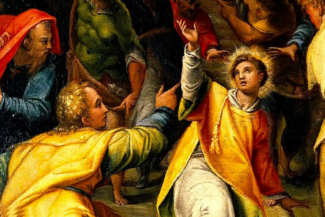 This may not be a controversial statement, but I love Christmas. I love Christmas trees, Christmas carols, Christmas cards, and cheesy Christmas movies on cable. I love the food and the family gatherings. And of course, I love to meditate on the great feast of Our Incarnate Lord’s birth into the world he was to save. I love everything that surrounds the Christmas holiday.
This may not be a controversial statement, but I love Christmas. I love Christmas trees, Christmas carols, Christmas cards, and cheesy Christmas movies on cable. I love the food and the family gatherings. And of course, I love to meditate on the great feast of Our Incarnate Lord’s birth into the world he was to save. I love everything that surrounds the Christmas holiday.
But there’s one thing that surrounds Christmas that I don’t love as much—or rather, that I had to learn to love. That’s the day after Christmas. After our solemn wait during Advent culminates in the joy of Christmas, what comes the next day on December 26? The feast of St. Stephen, the Church’s first martyr. That’s an odd pairing, isn’t it? And a bit of a downer. Why follow up this joyous feast with a memorial of death?
It’s no mistake. It’s no oversight on the part of whatever papal secretary put together the liturgical calendar. It actually demonstrates for us a beautiful truth.
RELATED: Recast Your Christmas Story
The coming of Christ changed the world. By his teachings and example, he called us to love our neighbors as ourselves, changing the way we relate to one another. By his sacrifice of love on the cross, Jesus changed our relationship with God. Through his suffering, he changed our suffering, raising it up from simple pain to a participation in our salvation. The whole world looks different in the light of Christ.
The witness of the martyrs is a prime example of this. St. Stephen, one of the first seven deacons of the Church, was stoned to death for professing the Gospel message. Many Christians have followed in his footsteps, saints like Perpetua and Felicity, Thomas More and John Fisher, Maximillian Kolbe and Edith Stein. Through their courage, the martyrs show the strength of their convictions, the depth of their faith. Through Christ’s death and resurrection, their deaths are transformed beyond brutal tragedies into inspiring examples, the seeds that help the Church to grow.
We see this with the feast of Christmas next to the feast of Stephen. The first martyr is placed alongside the birthday of his Savior. The light of the newborn Christ-child shines on this feast and shows us the joy found even in the sufferings our faith may call us to. They aren’t separate but intimately joined. It’s because of this babe in a manger and what he brings to the world that we can face the trials of this life with hope. It’s because of Jesus that Stephen could face his own death and ask God to forgive his murderers.
RELATED: Are Secular Christmas Carols Okay for Catholics to Sing?
We often feel that the joy of Christmas fades too quickly. We get caught up in the preparation for Christmas, and suddenly, it’s over, and we must wait another year before that joy comes around again. The feast of St. Stephen reminds us that this joy, this light, should shine through every day of the year, every moment of our lives.
It may sound cliché to say that the spirit of Christmas should live in us the whole year round. And if we responded to that by leaving our lights up through Labor Day, it would be. But if we respond like St. Stephen, by letting Christ live in our hearts and guide our lives, the true joy of Christmas, the joy at the coming of our salvation, will shine in everything we do. That’s a gift that keeps on giving the whole year.
Originally published on December 26, 2017.